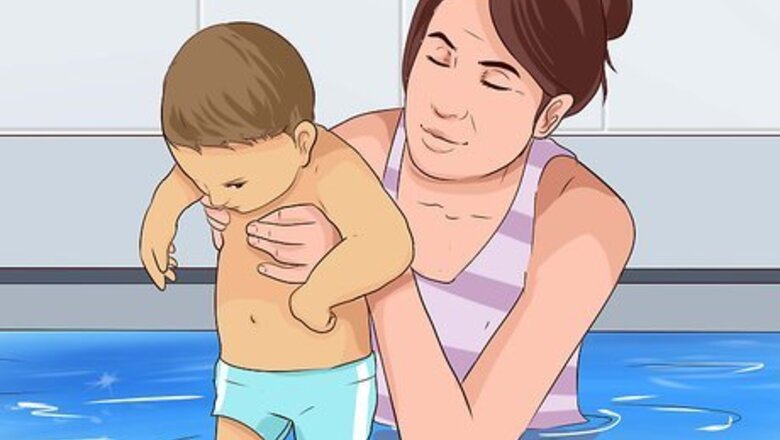
views
Before You Start
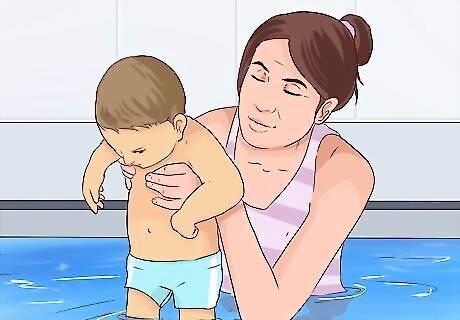
Learn when to begin. Although your child may not become a proficient swimmer until they're a few years old, you can start bringing them in the pool at a few months. From 6 to 12 months is usually considered a good time to introduce your child to the water because at this age children will absorb the skill faster. As long as you're gentle with your child and introduce them to the water gradually, you can begin as early as 6 months.

Assess your child's health. Make sure your child, whatever their age, is healthy enough to begin swimming. If your child has any health conditions you should consult your doctor before beginning swimming lessons.

Learn about child CPR. If you have a young child just learning how to swim, you should be familiar with basic first aid. Knowing CPR can save your child's life.

Dress your child in a special swim diaper. If your child is still in diapers, use a waterproof swim diaper to prevent any leaks and protect the health of other swimmers.
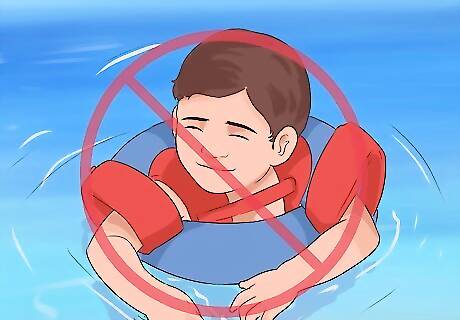
Avoid air-filled flotation devices. Blow-up devices like water wings are popular, but not recommended by pediatricians. If these spring a leak while your child is swimming, they can sink. These devices can also slip off. Instead, use a U.S. Coast Guard-approved life vest. These should be available at most sporting goods and pool equipment stores. When buying a life vest, look for the U.S. Coast Guard-approved label. For small children, the vest should have straps that hook under the legs to keep it from slipping over the child's head. EXPERT TIP Brad Hurvitz Brad Hurvitz Certified Survival Swimming Instructor Brad Hurvitz is a Certified Swimming Instructor for My Baby Swims, an adolescent swimming school based in La Jolla, California. Brad is trained as an Infant Swimming Resource (ISR) instructor with ISR's Self-Rescue® program. He specializes in training children aged six months to six years of age survival skills like floating on their back to breathe and swimming back to the wall, while also educating parents on how to better keep their kids safe. He has a Master of Business Administration from Oregon State University. Brad Hurvitz Brad Hurvitz Certified Survival Swimming Instructor Avoid using puddle jumper flotation devices. Puddle jumpers go across the chest and arms, keeping the child vertical and giving them a false sense of security. Wearing a puddle jumper teaches children that they are safe in an upright position even though that is the position many children without flotation devices drown in. Their mouths are below water in a vertical position versus when they float on their backs.

Secure all gates, locks, and ladders to your pool. If you have a pool, make sure your child can't get to it. Learning how to swim may make your child overconfident of their abilities and they might try to swim when you're not looking. Avoid accidents by completely blocking access to the pool when it's not in use.
Introducing Children Under Two to Swimming
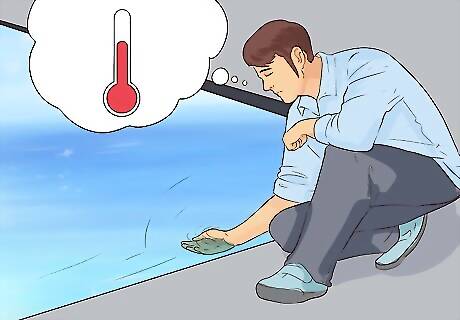
Check the water temperature. Infants require warm water, ideally between 85 and 92 degrees. If your pool isn't heated, you can try using a solar cover, which absorbs heat from the sun, to warm the pool.
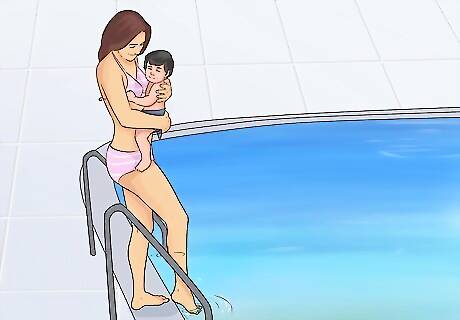
Enter the water slowly while holding your child. You should introduce your child to the water gradually. Many people, adults and children, drown because they panic in the water. By slowly exposing your child to the water, you're helping them overcome that fear. This will help them stay calm when learning more advanced swimming skills.
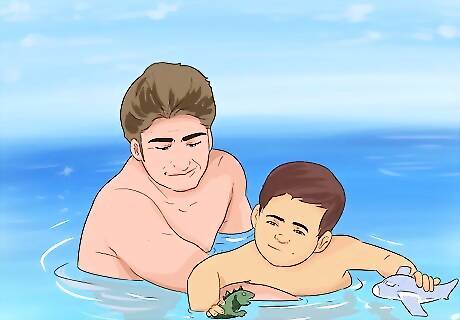
Make the experience fun. An enjoyable first time in the water will teach your child the joy of swimming. Play together with toys, teach them to splash, sing songs, and be attentive to make sure they are enjoying himself.

Introduce your child to the motion of swimming. Lock their arms around your neck while they're facing you and start walking slowly backwards.

Use your hands to guide their feet in a kicking motion. With some practice, your child will learn to start kicking in the water by themselves.

Help your child to learn to float. They can best learn their own sense of buoyancy by remaining still in the water on his back, but at this stage they are sure to need your support. The most important part of learning this skill is getting them to relax.

Play a game of “superhero” to show them they can float in the water. Carefully holding your child around the belly and being certain to keep their head above the water, you can both pretend they are a superhero flying.
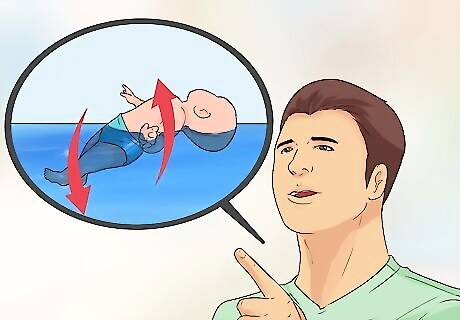
Describe and demonstrate floating. Seeing that you can float will reassure your child it is possible. You should take a moment to describe that different parts of the body float better than others. Deeper breaths will make the lungs more buoyant, and the lower body usually sinks.
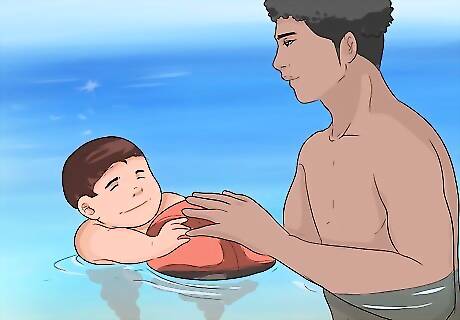
Teach the principle of floating with balls and balloons. Now that your child understands a little bit more about floating, have him get a sense for the buoyancy of other objects. Have your child push toys and other floating objects under the water and laugh with him as he makes bubbles and splashes.
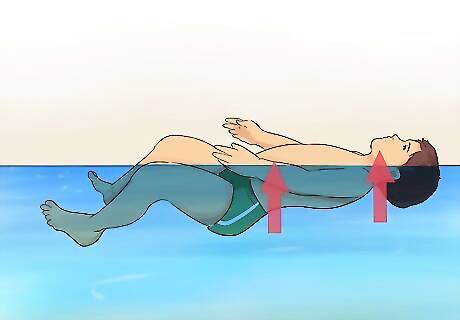
Practice the back-float on dry ground. Children are often uncomfortable with the sensation of the unsupported feeling of the back-float in water. A common reflex is to lift the head and bend at the waist, which will cause your child to sink.
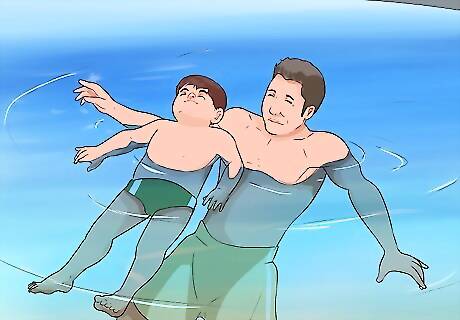
Do a tandem floating trial run. By resting your child’s head on your shoulder and holding him carefully, you can practice floating together. Sing a relaxing song together can have a calming effect in addition to other positive benefits of being skin to skin with your child.

Take your child under the arms with both of your hands while in the water. He should be in front of you in case he panics. Count down from three, exhaling lightly to blow on his face on the count of one. This will serve as a signal to your child that you are about to turn him on his back and will help prevent panic.
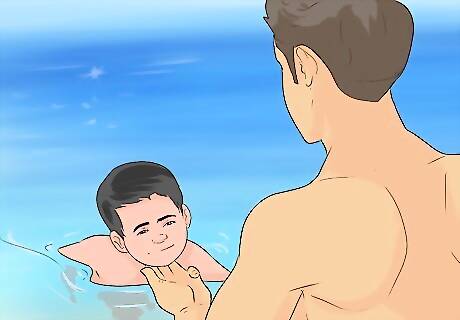
Turn your child gently onto his back as you exhale. Use your non-dominant hand to support his head, keeping it above water. Use the other to touch him in a reassuring way and offer support as necessary. He may squirm when placed in this position. Keep supporting him until he settles down. When he calms, little by little stop supporting his body while still holding his head. Allow him to float.
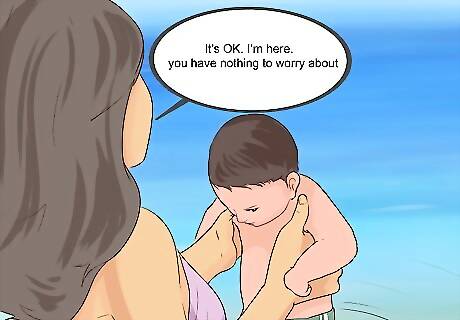
Respond appropriately to panic. If you are emotional, it might appear you are validating your child’s panic response. Use positive affirmations to restore clarity, saying things like, “It’s OK. I’m here. You have nothing to worry about.” Smile and laugh to show him everything is alright.

Dip your child's head in the water carefully. This will familiarize him with being underwater and diminish his fear of it.
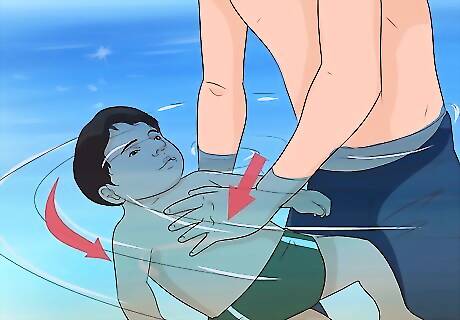
Place your dominant hand on the child's back and your other hand on his chest. Count to three and gently submerge his head. Bring it back up immediately. Use smooth motions. Jerky motions can hurt your child's neck. Allow your child to rest before doing this again.
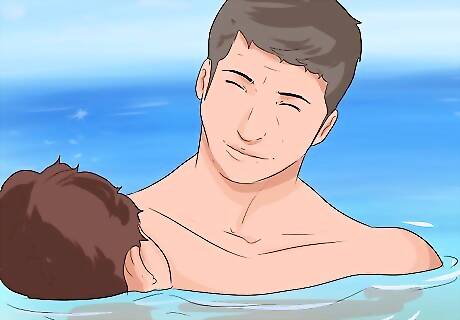
Remain calm. If you are clearly nervous or scared, your child will believe the water is something to fear. At this stage, you want to stay positive and show him that he doesn't have to be afraid of the water.
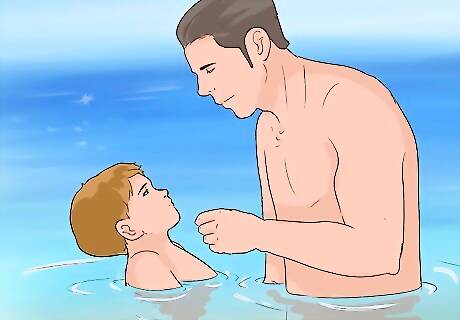
Supervise your child at all times. At this early age, your child can't swim independently. You should always be in the pool with him at this stage.
Teaching Children Ages 2-4
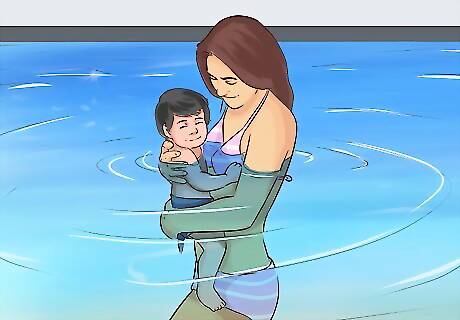
Introduce your child to the water if new to the experience. You can do this in the same fashion described for children under two. Help him overcome his initial fear and get him comfortable in the water. Once he is at ease, you can move on to some more advanced lessons.
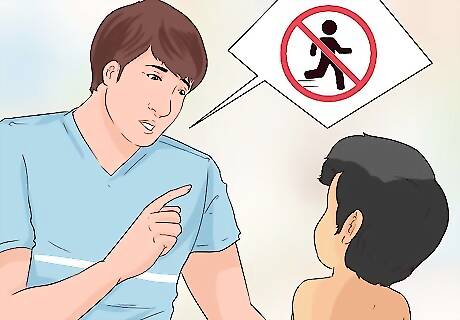
Teach your child the rules of the pool. At this age, your child should be able to understand what is and isn't allowed in the pool. Generally accepted pool rules include: No running No horse-play No diving Swim with a buddy Stay away from drain covers and filters
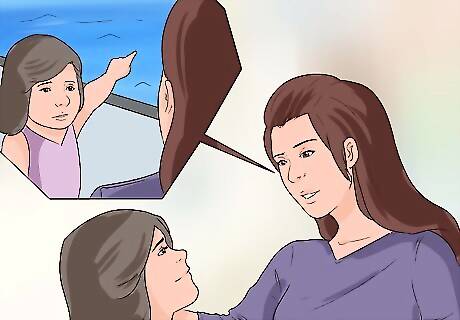
Be clear that your child has to ask your permission before going in the pool. Most drowning cases under five result from inadequate supervision.

Explain swimming activities clearly before practice. At this age, your child can understand descriptions of swimming activities. If he is ready for something new, he is more likely to absorb the lesson if he is given brief instruction ahead of time. Show the motions for swimming activities outside the water before getting in. You might want to address new sensations, like the sense of buoyancy that can be felt in the chest when floating, pressure in the ears, or the muffled quality of sound beneath the water.
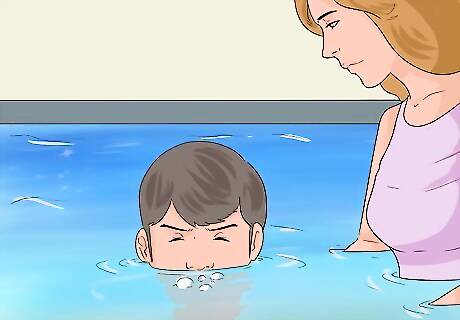
Blow bubbles in the water. Have your child submerge just his lips in the water and blow bubbles. This will help him with breath control and help prevent swallowing water as he starts learning to go underwater. If your child is hesitant, demonstrate this first. When you take your mouth out of the water, make sure you have a smile on your face. This will help show your child that there is nothing to be afraid of.
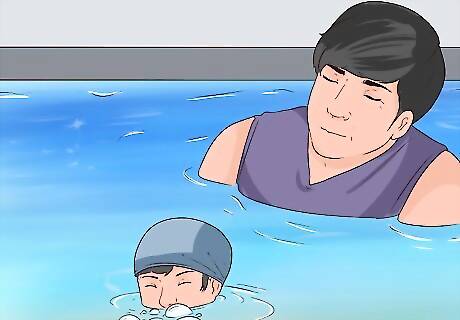
Play a bubble blowing game. Tell your child to talk to the fish, make a noise like a tractor, or blow as many bubbles as he can in the water. This makes the lesson fun while you teach your child a valuable swimming skill.
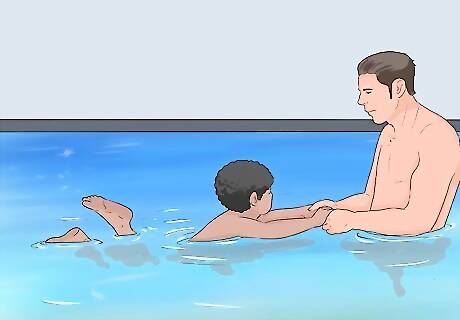
Teach your child to swim by kicking. Stand facing your child. Hold his arms out in front of him. Then start walking backwards, having your child kick his feet as you move. Verbal cues like "kick, kick, kick, kick" can help your child remember this motion.
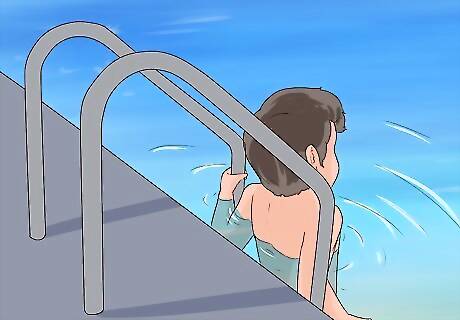
Teach your child to swim with his arms. This is a simplified, arms-only version of the freestyle, which is where you paddle with your arms while kicking with your legs. Have your child start by sitting on a pool step or ladder so the water is roughly up to his chest.

Have him start with both hands under the water and on his hips. He should extend one arm straight out of the water and bring it above his head.
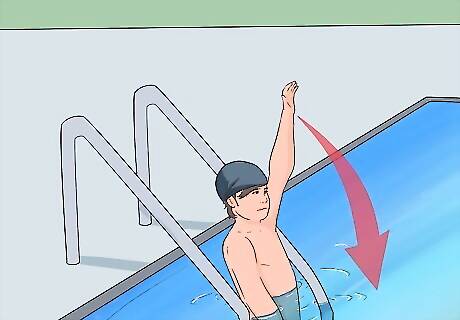
Have him keep his arm straight above his head. He should bring it back to the water in a downward slapping motion, making sure he keeps his fingers together as he drives his hand into and through the water.
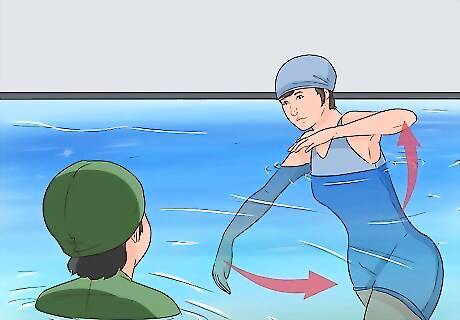
Have him pull his hand back to his hip after his arm reenters the water. Repeat this motion with the other arm. Direct him to use his arms like he would if he were really swimming.
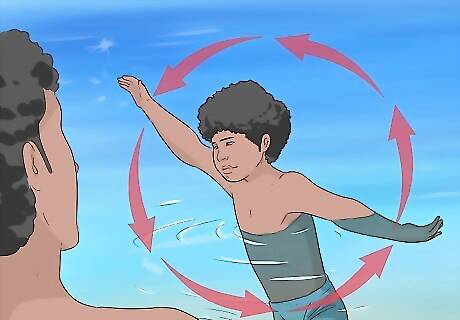
Practice swimming in this way by playing "Catch the Fishies.” Pretend that with the circular motion of his arm he is catching a fish with the down stroke and pulling it toward a basket on his hip. Make sure he keeps his fingers together, so the fish don't escape.
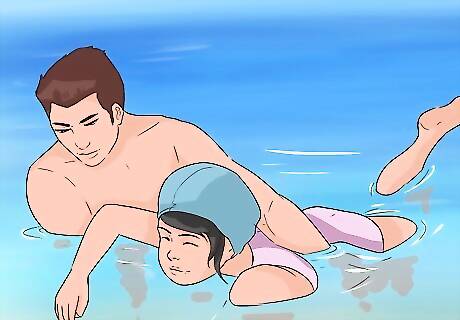
Guide your child to the steps or ladder. Standing a few feet into open water, hold your child with one hand on his chest and one around his waist. Count to three and glide him through the water towards the steps or ladder. While doing this, have him combine blowing bubbles, kicking his legs, and swimming with his arms. This will help him start using all the motions necessary for independent swimming.
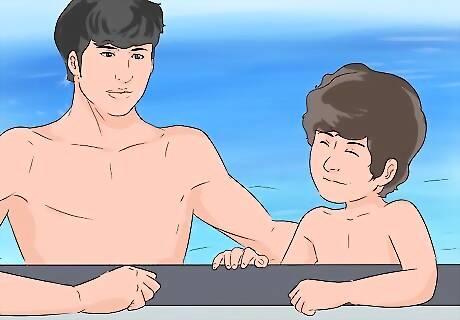
Encourage your child to use the wall. Holding onto the wall is a good way for him to make his way back to the shallows and also helps teach him to maneuver on his own. It shows him a safe place he can use to stay afloat if he falls in the water, gets tired, or is scared.
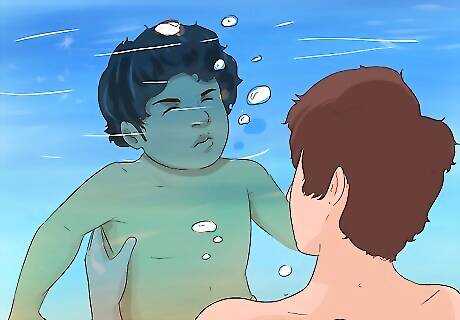
Take your child underwater. Instead of just dipping his head under, you can now try to keep him under for a few seconds. This will teach him to hold his breath underwater. Make sure you tell him to close his eyes and mouth and hold his breath. Remember to explain what you're about to do to avoid scaring your child. Never put your child underwater unexpectedly. This will scare him and could make him afraid of the water.
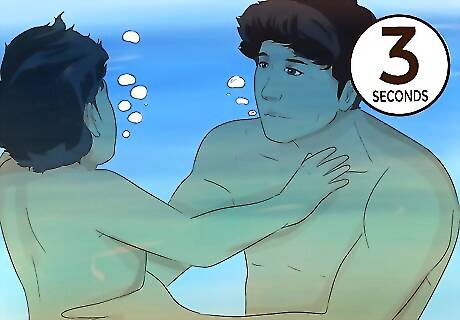
Count to three and smoothly submerge him in the water. After two or three seconds, bring him back up. You can increase this gradually as your child gets accustomed to it. If he seems hesitant, try counting to two or three to show him that he'll only be under the water for a very short time. It may make your child more comfortable if you go under first. Remember to smile and laugh when you come back up so he knows there's nothing to be afraid of.

Allow your child to start swimming independently with a life vest. At this point, he has all the basic skills needed to start swimming, he just needs practice putting it all together. A life vest will allow him the freedom he needs to start combining all these techniques and swimming on his own.
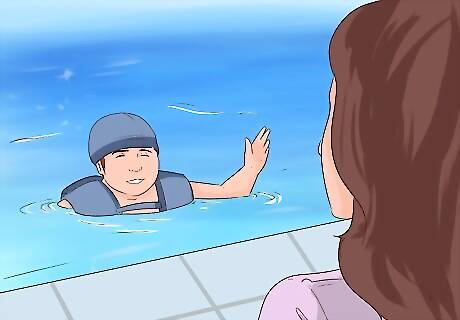
Continue supervising your child whenever he is in the pool. Remember that even if your child is capable of swimming without you holding him, he should still never be left alone.
Teaching Children Older Than Four
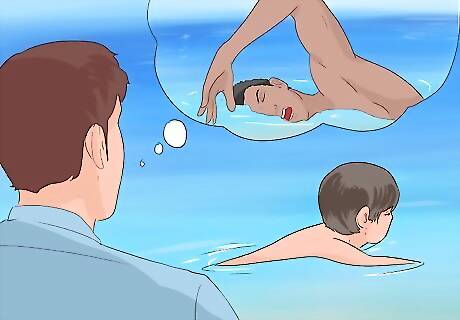
Confirm that your child is proficient with all basic skills. If he is comfortable in the water and is able to swim at or beyond the level described for 2 – 4-year-olds, then you can move on to more advanced swimming techniques.
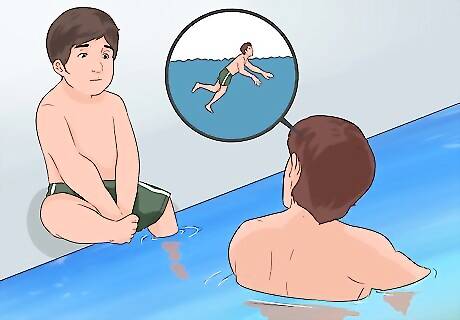
Teach your child the Dog Paddle. This is a fun and simple swimming style that is often used by young children learning to swim. The ideal water level for the Dog Paddle is about chest high.
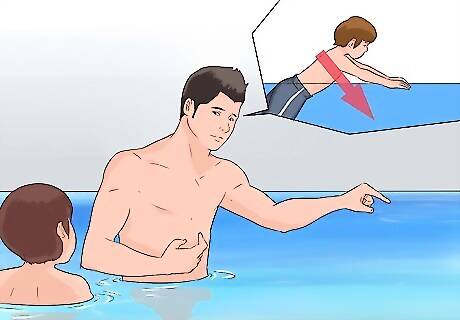
Tell your child to enter the water belly first and cup his hands. Making downward scooping motions with his fingers together, he should “dig” through the water while kicking his feet, much like a dog or a horse might swim. Have fun while learning the Dog Paddle by searching for videos of dogs swimming online.
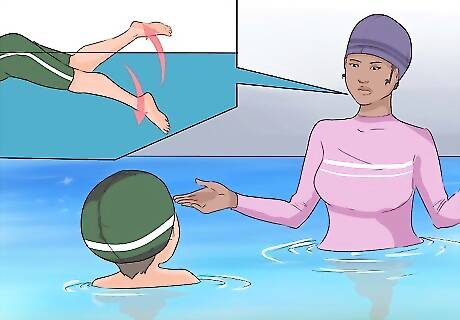
Tell him to kick his feet a little below the surface of the water. Chances are he will try to fully extend his legs, but short, fast kicks offer more power. To improve form, have him point his toes while kicking.
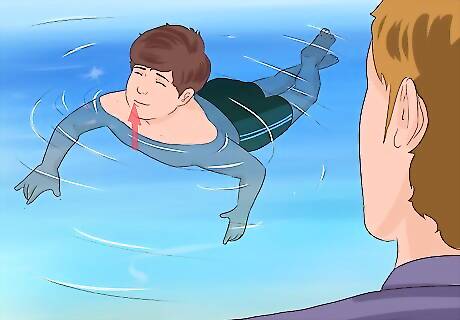
Have your child keep his head above water with his chin on the surface while paddling and kicking. He might need support while learning to coordinate his arms and legs, but as he gains confidence you should supervise independent swimming.
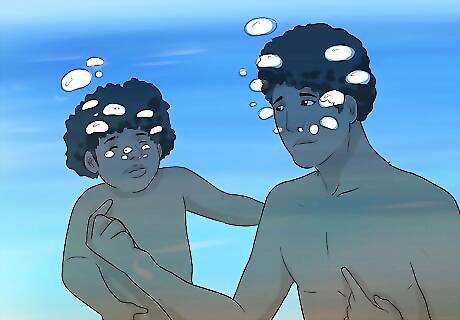
Teach him to blow air out through his nose underwater. To properly swim with both hands, your child will not be able to plug his nose while swimming. Start with a game to see who can make the most bubbles using only air blown out the nose!
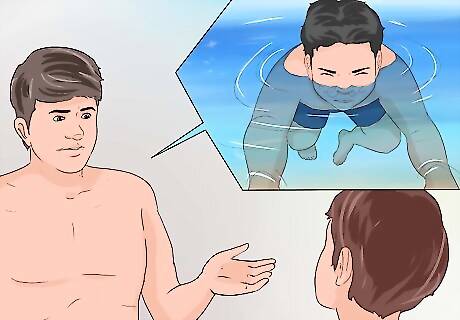
Encourage him to practice regulating his underwater nose-exhale. In the beginning, your child might blow out all his air in one burst out of fear the water will rush up his nose. Stay close in case he accidentally takes on some water and needs your support. In the event he has the unpleasant experience of getting water up his nose, respond appropriately. Give him warm encouragement by saying things like, “That happens sometimes. It’s OK!”
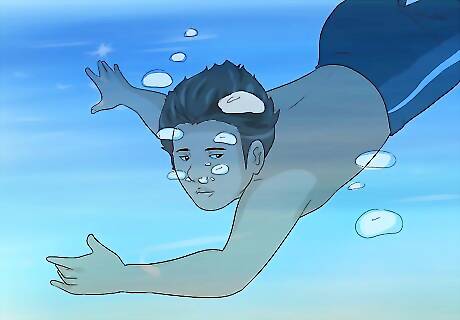
Practice moving around underwater with the nose-exhale technique. At this point, your child might not be the most coordinated underwater, but allow him to get a feel for moving around underwater without plugging his nose. This will make it easier for him to transition to swimming a proper stroke.
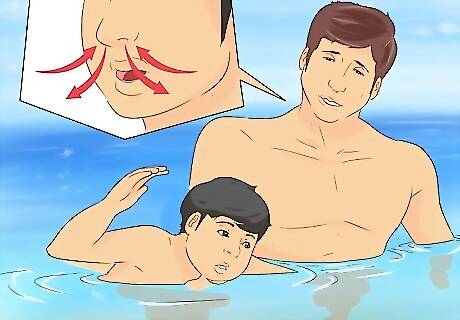
Teach your child to breathe bilaterally between strokes while swimming freestyle. You should approach this exercise with patience, as this is a complicated technique that may take some time.
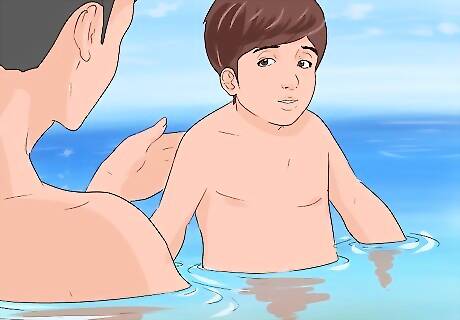
Have your child sit on the steps or stand in the shallows. He should be about waist or chest deep in the water. Be aware that your child might have eyes that are sensitive to chlorine.

Combine the arms-only swimming stroke described for younger children with short, fast kicks below the surface of the water. Practice in the shallow end and allow him to feel how his arms and legs sync up without submerging his head. Regularly, have him turn his head to practice the motion of turning out of the water to breathe. He should alternate the side he turns every third stroke.
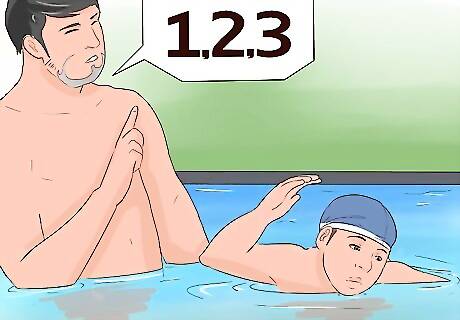
Cue breathing and help your child to find a swimming rhythm. Do this by counting his strokes and having him turn his head and take a deep breath with the third stroke. Alternating sides will keep his form symmetrical.
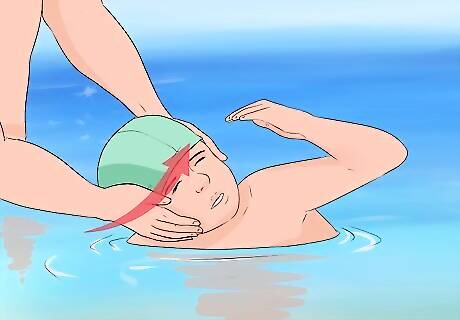
Hold him in the water with his stomach down, feet off the bottom of the pool, and your arms supporting him. Have him dip his face in the water and practice swimming two strokes, turning his head for a breath on every third stroke. With each breath, he should alternate sides.
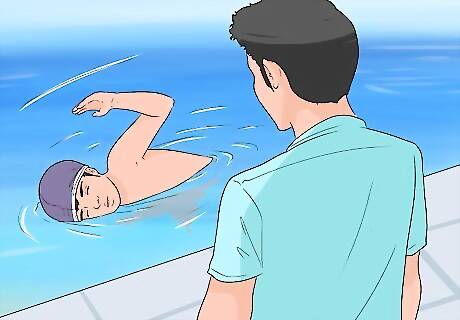
Supervise him trying this motion independently. Once he is comfortable, he can graduate to swimming with a life vest and, after mastering that, he can begin supervised swimming on his own.

Let your child swim to the other side of the pool. When he is experienced enough, you can try this without a life vest. If not, it is fine to start with a life vest on.
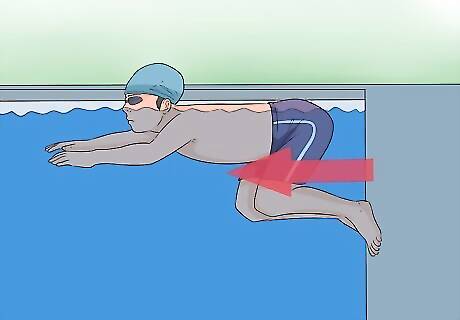
Have him stand or float at one end of the pool and push off the side with his legs. When he stops moving from the push, he should start kicking and stroking with his arms until he reaches the other side. Make sure you follow closely, especially if he isn't wearing a life vest.

Teach your child to roll over from his back. This will help if your child falls in onto his back.
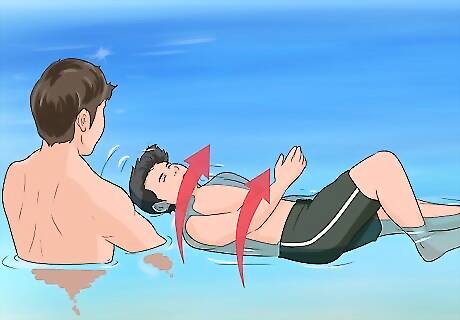
Have your child start by floating on his back. Tell him to drop one of his shoulders towards the bottom of the pool. He should roll the rest of his body to follow the motion of that shoulder. When he rotates onto his stomach, have him swim to the side of the pool.
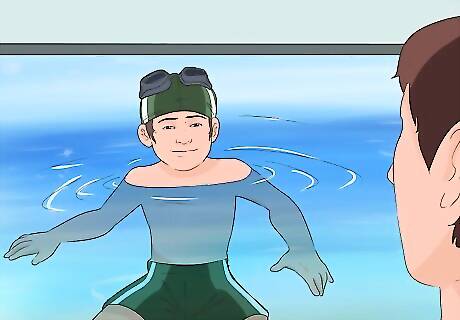
Teach your child to tread water. Treading water is an important skill in case your child needs to stay afloat in the water for a long period of time. It will keep him upright in the water and able to interact with toys and friends while floating.

Teach him to get back to the ladder if he falls in. Do this by having him jump off the ladder towards the center of the pool. Once in the water, he should immediately turn around and swim back to the ladder. This basic technique could save your child's life.
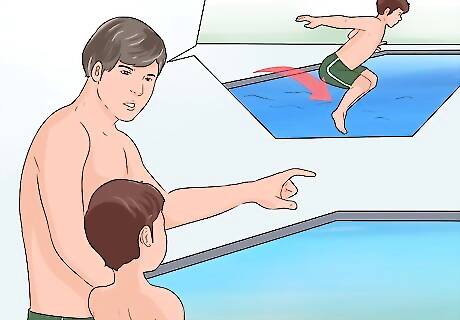
Make sure your child always jumps towards the center of the pool. This will teach him that it is only acceptable to jump to the middle, where it's safest, and not to the sides, where he could get hurt.
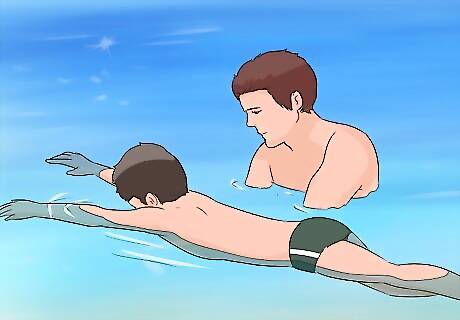
Teach your child more advanced strokes. Now that your child is more experienced, he can start learning some real swim strokes. The following are some of the most common swimming strokes your child can learn. Freestyle: Do Three Basic Strokes while Swimming Breaststroke: Swim Breaststroke Efficiently Backstroke: Do Three Basic Strokes while Swimming Sidestroke: Swim the Sidestroke













Comments
0 comment